Big Trip Day 237: In Our Volcano Era
Hi! It's me Justin, writing to you as we airport hop through Singapore and Qatar on our way to Greece. I’ll do my best to recount our final adventures in this corner of the world before we get to the next continent…
After four blissful months in West Sumbawa, we decided that our surf idiot summer had to come to an end. Remembering from somewhere deep in the back of our sun-baked minds that there is more to life than surfing, we reluctantly set a date to move on from our seemingly perfect life at the beach to find something fresh and exciting.

Our first stop, the Gili islands, was just a short ferry ride away. You may have noticed that there is usually a specific activity associated with the places we travel. In this case, freediving is the activity that brought us to Gili Trawangan, more commonly known as “Gili T.” Gili T is known as a bit of a party island, but Dory and I were there to take a freediving course! The level one certification in freediving teaches you how to dive 10-20 meters down into the ocean while holding just a single breath of air.
Each day, our instructor took us out on a boat to a random spot way off shore. From there, we jumped into the sea with nothing more than our snorkel, mask, and fins, and a buoy that had a weighted rope attached to it. The instructor then set the length of the rope line up to 20 meters deep, and provided us guidance to help us attempt to swim straight down to the end of the line and back up while holding our breath. In water this deep, there’s nothing to look at, just the endless blue and the rope dangling into the sea.
Unlike with our scuba diving course, freediving skills were actually quite challenging and frightening to acquire. The main trick to getting over the fear of running out of air is to fully understand and accept that you have a lot more oxygen storage in a single breath than you might think. And the feeling that makes you believe that you are running out of oxygen is actually just CO2 trying to escape from your body, which with practice, can actually be safely ignored for quite a long time. The other secrets to success are to take in an enormous breath before diving down, move efficiently, stay mentally relaxed, and equalize your ear pressure about every meter (that last one is generally the most common challenge). Dory found herself unable to surpass 8 meters for the first two days of training, and the minimum depth required to receive the certification is 10 meters. Through a heroic effort and a bit of visualization, Dory overcame her mental block and hit 12 meters on the last day; I couldn’t be more proud.
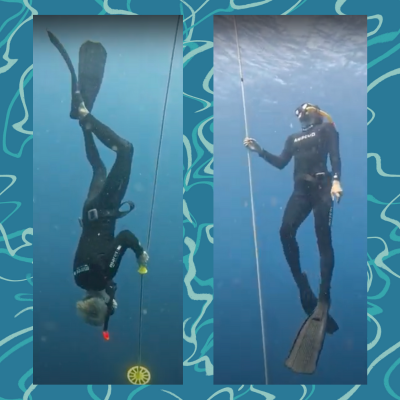
We also practiced doing a static breath hold in the pool, which is where I excelled, likely because for unknown reasons, I considered this a fun thing to practice doing as a kid. During our pool session, I ended up holding my breath for a whopping 4 minutes, which prompted the instructors to double check that I hadn’t lost consciousness.
Most freedivers focus their efforts on diving to the deepest levels possible, the world record being 136 meters (check out the Netflix documentary, The Deepest Breath.) However, the main motivation for Dory and I to increase our time duration underwater is simply to maximize the time we can observe fish up close. You might be thinking, isn’t that what scuba diving is for? Well, yes. But scuba diving is by far the most expensive activity we do, and freediving, at least the way we do it (extreme snorkeling,) is free. The other benefit to having a longer breath hold is to feel more comfortable while out surfing, during times when we are inevitably being tumbled by big waves.

After putting this new certification under our belt and enjoying the people watching on Gili T (you can’t miss the Thursday pub crawl,) our remaining goal was to experience another one of Indonesia's incredible marvels: volcanoes. You can basically throw a stone from anywhere in Indonesia and hit a volcano. With so many volcanoes to choose from, we decided to focus on those that were the most on-the-way as we headed west via bus, ferry, and train towards Java, where we had a flight booked to depart Indonesia.
But before I continue this story, I have to interject a flashback. Bear with me – it might seem unrelated, but I’ll bring it back around:
Back when we were on a visa run in Kuala Lumpur in early July, Dory, who is officially our Chief Housing Officer (CHO), booked us into a very fancy hotel called the Alila, which we paid for using just 5,000 credit card points a night. In that hotel, one floor down from our room, there was a Michelin selected restaurant called Entier. Upon investigation, they offered a 5 course set lunch for just $25 each, so we decided to reserve a table. The only catch was that they had a dress code that required closed-toed shoes, and all we had brought to KL were our Bedrock sandals (which we’ll celebrate in a future newsletter.) Since we had been talking about trying to hike some volcanoes at some point, we then had 2 reasons to buy shoes. So in preparation for our lunch reservation the next day, we went out shopping for some fancy lunch shoes that could also serve as volcano hiking shoes. We found some inexpensive trail runners at the mall, which performed marvelously at the restaurant, and would hopefully do just as well at bagging a few volcano peaks.
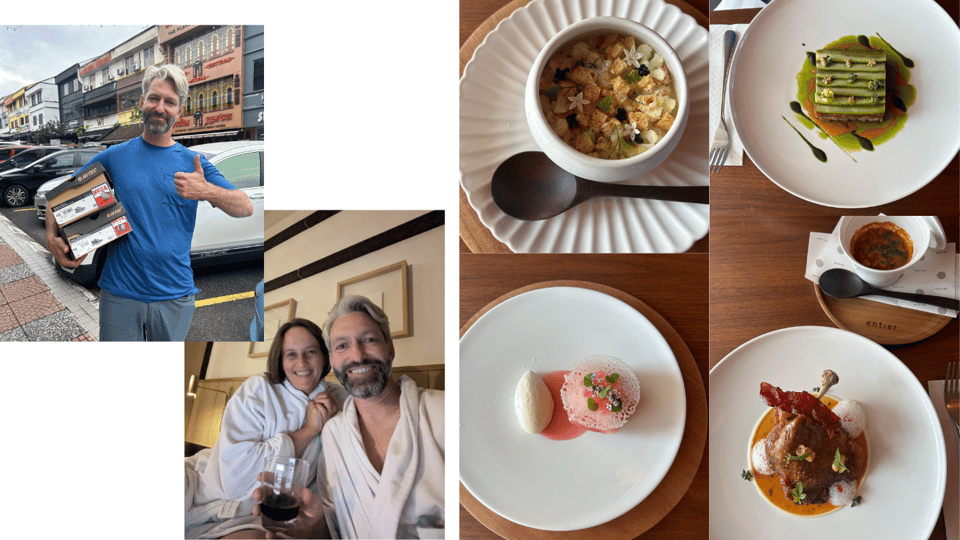
Okay, back to the volcano story…
Our first stop was Gunung Batur in Bali (Gunung is the Indonesian word for volcano.) Up until this point, we had mostly avoided spending time in Bali because it’s reputed to be completely overrun by tourists. But we figured we should give it a chance and see for ourselves. Our first observation was that Bali has some of the most interesting culture in Indonesia, partially due to the fact that the people on the island are primarily Hindu rather than Muslim. Hinduism, especially the Balinese flavor, comes with lots of interesting architecture, temples, art, and statues. The statues in particular are somewhat nightmare inducing. For example, the deity shown below called Patung Kambakarna Laga, symbolizing protection and security, kindly welcomes you to a botanical garden in northern Bali.

We traveled to Mount Batur by motorbike. We drove along the winding roads that rolled through lush jungle-covered hills, passed countless monkeys waiting for someone to toss out some edible garbage, and stopped to see waterfalls that were conveniently on the way. We eventually made our way to the town of Kintamani, located at the base of Gunung Batur. Dory (the CHO) booked us into a lovely place called Triangle Homestay, equipped with tiny A-frame bungalows and private volcano-fueled hot springs. Fun fact: volcanic hot springs don’t smell like sulfur! We assume this is because they’re being heated directly by the volcano itself… but don’t quote me on that.
It was here where we were introduced to the concept of the “guide mafia”. Our host told us it is quite easy and perfectly legal to hike up to the volcano crater directly from our bungalow, but that some people will say it’s required to use a guide, and if we go without one, we should not mention where we are staying so that he doesn’t get in trouble. Dory and I have learned that we prefer not to be guided, especially when it is completely unnecessary, so we headed up the trail solo.
As expected, the trail was incredibly straightforward, and the only difficulty we found was when we ran into several members of the guide mafia asking us where our guide was and telling us that it was illegal for us to be there without one. Fortunately, with some smooth talking, the mafia let us proceed to the top without cutting off our pinkies. At the peak, we were rewarded with some spectacular views of an enormous crater covered in vegetation, looking as though it hadn’t erupted for a long time. But scattered about were several areas venting steam, as if to remind us that the volcano was still very much alive and could decide to erupt again anytime. The valley below was covered by an expansive black lava field, which even after several decades still appeared to be unchanged in any significant way. We eventually made our way down and safely arrived back to our homestay. Our fancy lunch shoes, unfortunately, were already falling apart.
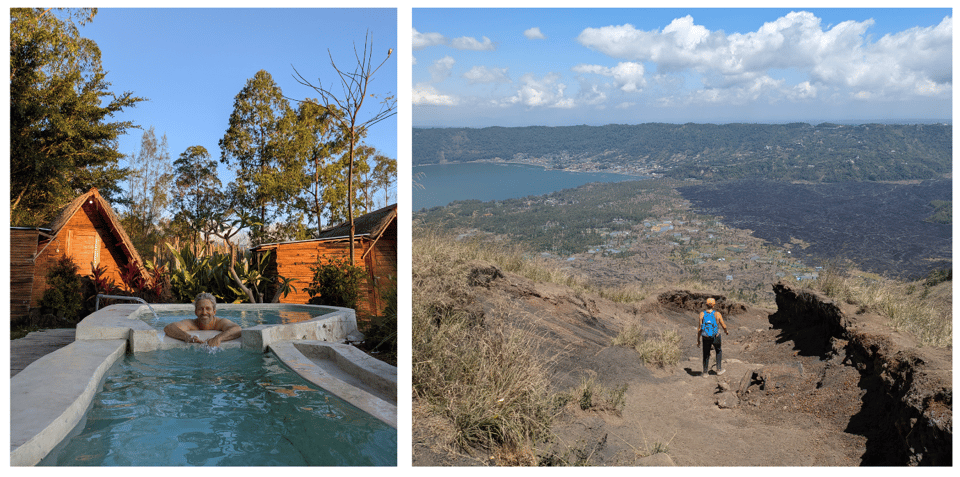
The next day, we got in one more soak at our private hot spring and headed to Ubud, which is known as the spiritual center of Bali. We visited an art museum and marveled at the gorgeous and impressively detailed Balinese style of painting. We walked everywhere we could, but found it to be incredibly difficult due to the lack of sidewalks and the excess of motorcycles. We hadn’t picked up on any “spiritual” vibes (just scooter traffic and general inconvenience) until we paid a visit to the Yoga Barn, a yoga school compound that’s basically an alternate universe. Once inside the Yoga Barn campus, you become surrounded by westerners in yoga pants, and you are forced to decide what to do first: join the ecstatic dance party, take a shot of lemongrass and ginger, attend a sound therapy session, or hang out on a bean bag with a white guy playing a didgeridoo. In classic style, Dory and I took the beginners yoga class because it was free, and then hung out for a few more hours to use the wifi and enjoy a delicious western lunch.

After just 5 days in Bali, we understood how Bali’s beauty and appeal had turned it into such a tourist magnet, but also why so many people say Bali has been ruined by tourism. The traffic is horrendous, the western culture has taken over a significant area, and you get a sense that the locals have simply had enough – and rightfully so. It was fun to catch a glimpse of what Bali is all about, and we can verify that it’s still possible to find plenty of hidden gems if you know what to look for, but it’s not on our return visit list.
We continued west, ferrying over from Bali to the island of Java, where we stayed in a town called Banyuwangi. This was the starting point to go see Gunung Ijen, one of the most notable volcanoes in Indonesia, famous for the blue flames visible in its live lava fields. Unfortunately, upon arrival we learned that this volcano had been closed for the last month due to increased activity (aka potential eruption). We changed course and instead decided to hike the much lesser known volcano next to Gunung Ijen, which is called Gunung Rante. Under normal hiking criteria, Rante offered us an excellent day out with remarkable views, but not the jaw dropping experience we were hoping for. But that’s how it goes sometimes, and now we have a good reason to come back.
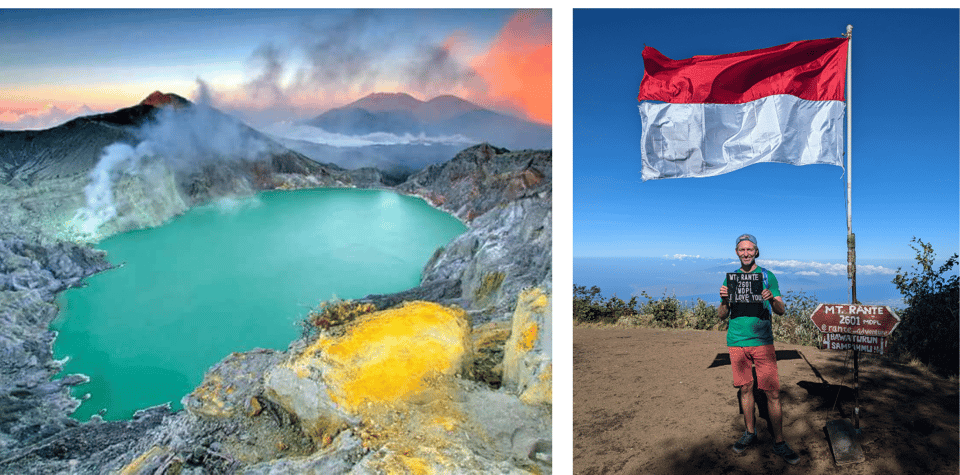
From Banyuwangi, we continued westward by train, heading towards Gunung Bromo, our final volcano objective of the trip. This volcano had the most easy access of all, but was by far the most stunning. In fact, you can drive right up to the base, and then walk up a literal staircase to the edge of the crater. Once you reach the top of the stairs and peak down into the crater, you can’t help but gasp. It feels as though you are staring down into the center of the molten magma filled earth, which could explode at any moment. We gazed deep into the crater, mesmerized by the toxic sulfurous vapors that spewed from the depths of a gurgling gray sludge; it was absolutely terrifying.
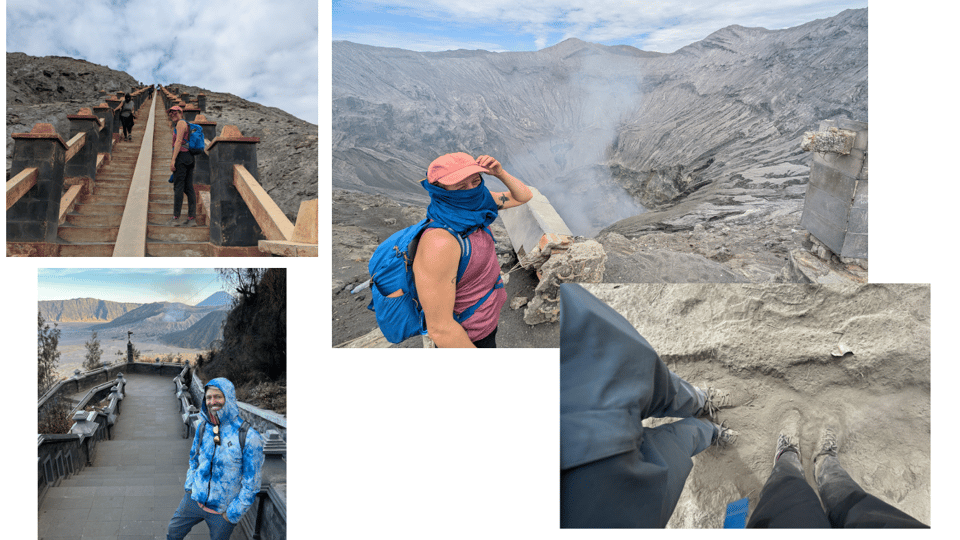
Once we had inhaled more than enough sulfurous gasses, we headed back down the trail and up to a different viewpoint about a half mile from the crater. From this new location, we had the vantage point to see the expansive valley with the entire chain of volcanoes in the distance. This turned out to be the most breathtaking view of our journey thus far. By arriving in the late afternoon, we nailed the timing perfectly to be there during the golden hour with the most exceptionally beautiful light and only a few other people around.
A curious phenomenon that occurs all over Indonesia is that everyone seems to be obsessed with the sunrise. Every single volcano hiking tour company routinely sends tourists off at 3am towards the volcano to ensure that they can hike up to the top and claim a good spot to view the sunrise from, where they are accompanied by literally hundreds of other tourists. Then, by 10am, all the tour groups are gone and the trails are mostly empty. We never figured out why nobody seems to like the sunset, but Dory and I were happy to have the chance to sleep in and avoid the crowds during our self-guided volcano tours.

And just like that, our time in Indonesia was wrapping up! Our third and final visa was due to expire a few days before our flight from Singapore to Greece (via Doha) was scheduled. So instead of going to Singapore early, which would be extremely expensive, we decided to head back to Malaysia for a few days, which surprisingly turned out to be a great strategy.
In an attempt to explore beyond Kuala Lumpur, we flew to Penang, which is known as the food capital of Malaysia. This was a very welcome description since by that point, we were hoping to never see an Indonesian nasi goreng or mie goreng ever again for the rest of our lives. In Penang, we stayed in the Little India section of Georgetown, a UNESCO World Heritage city, and ate our weight in Indian and Malaysian cuisine. Georgetown is super charming, filled with incredible art, walkable streets, and delicious food from all over the world. We would have been happy to stay even longer, but after eight months, the Southeast Asia chapter of Big Trip was coming to a close.

Our time in Southeast Asia has been truly special. We were received with kindness and delight by so many people, and spent time in some of the most beautiful natural places we’ve ever seen. It’s bittersweet to be moving on, but we’re comforted by the knowledge that we’ll absolutely be back. Even in five months, we feel like we have just barely scratched the surface of what Indonesia has to offer! And of course, Vietnam and Thailand were both incredible places, and we’re eager to explore more there as well.
After two long flights and an overnight layover in Doha, our Greece era will begin. We’re excited to eat vegetables, drink wine, and spend time with the friends and family coming to visit us in a totally different part of the world.
Love,
Justin & Dory